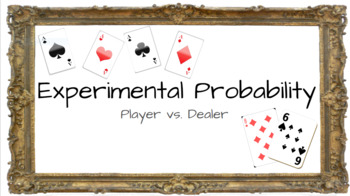Probability: Experimental Probability - Deck of Cards
- Google Drive™ folder

Description
Looking for a fun and engaging way to introduce experimental probability?
In this lesson, student players must compete against a dealer to guess the suit of the next card drawn. Easily use the included slides to work through the 40-60 minute activity. All you need are the slides, the following handout (optional,) and cards! Jumbo playing cards are a great way for your class to compete together. You may also choose to use several decks of regular playing cards for students to work in partners or groups!
In this activity, students must state their hypothesis, design their experiment, conduct their tests, and draw conclusions. Students can use this real world example to see if the odds are ever really in their favor when playing simple card games.
Your class will have a blast guessing cards and learn a TON about probability and the reality of chance in games!
Have a question? Send a message or leave a comment!
Thank you! ***Muggle Math***




